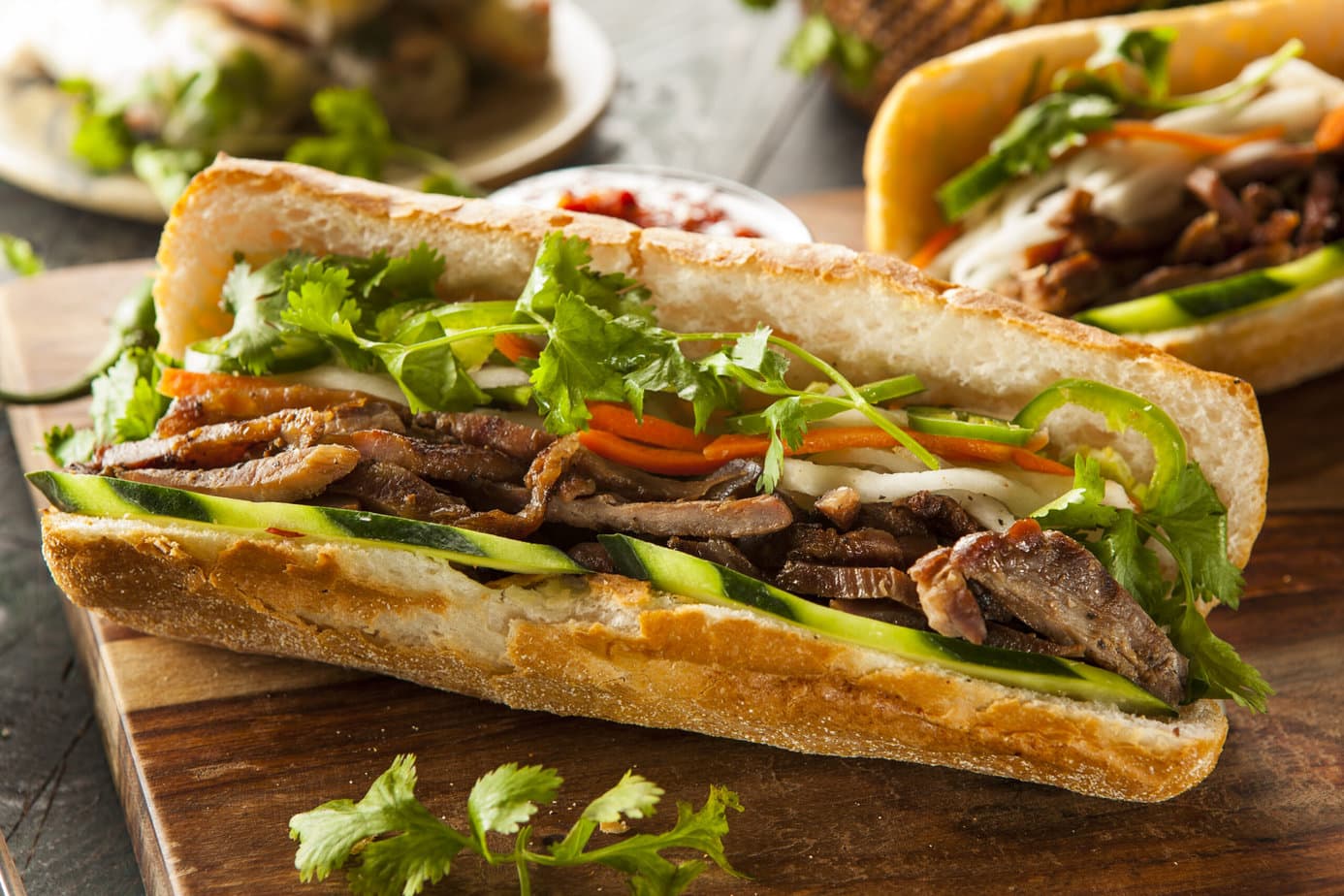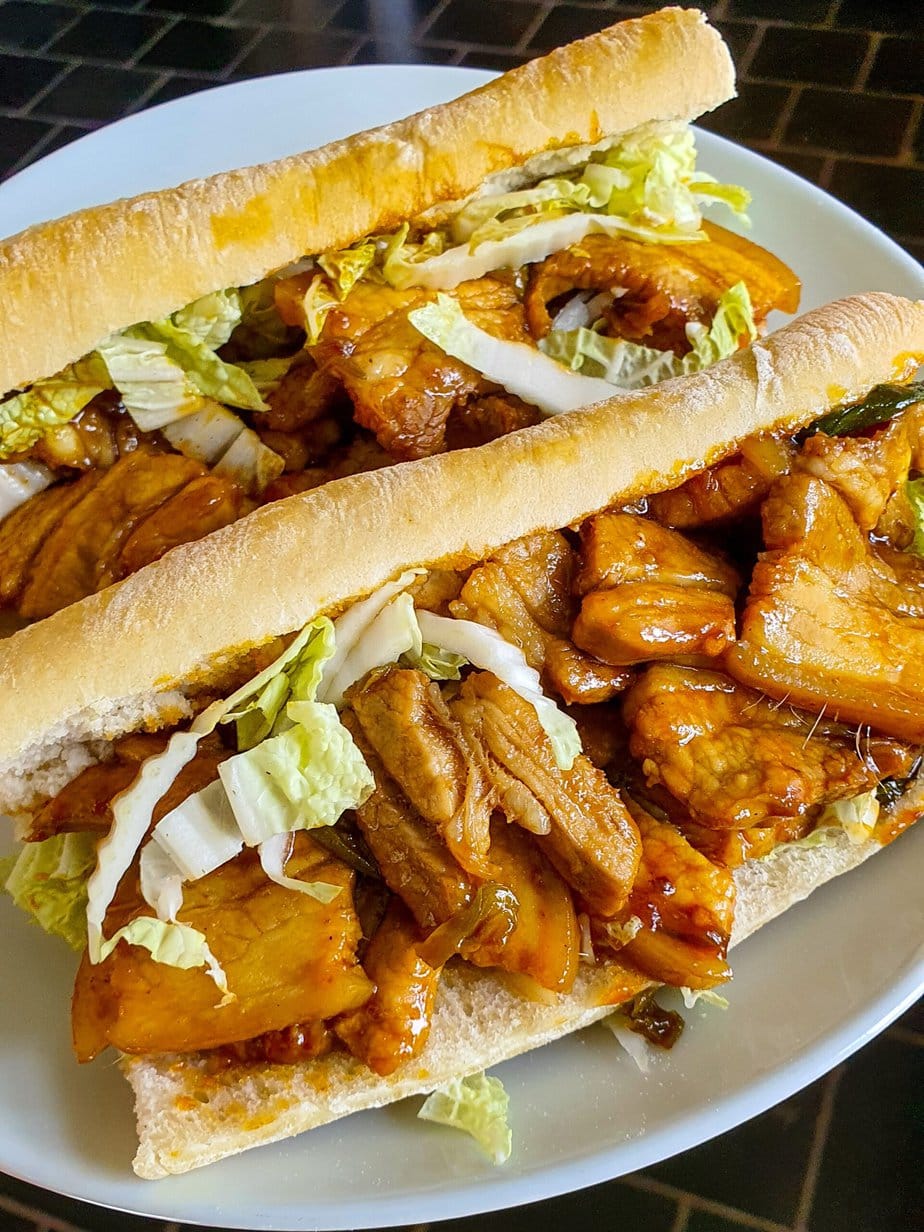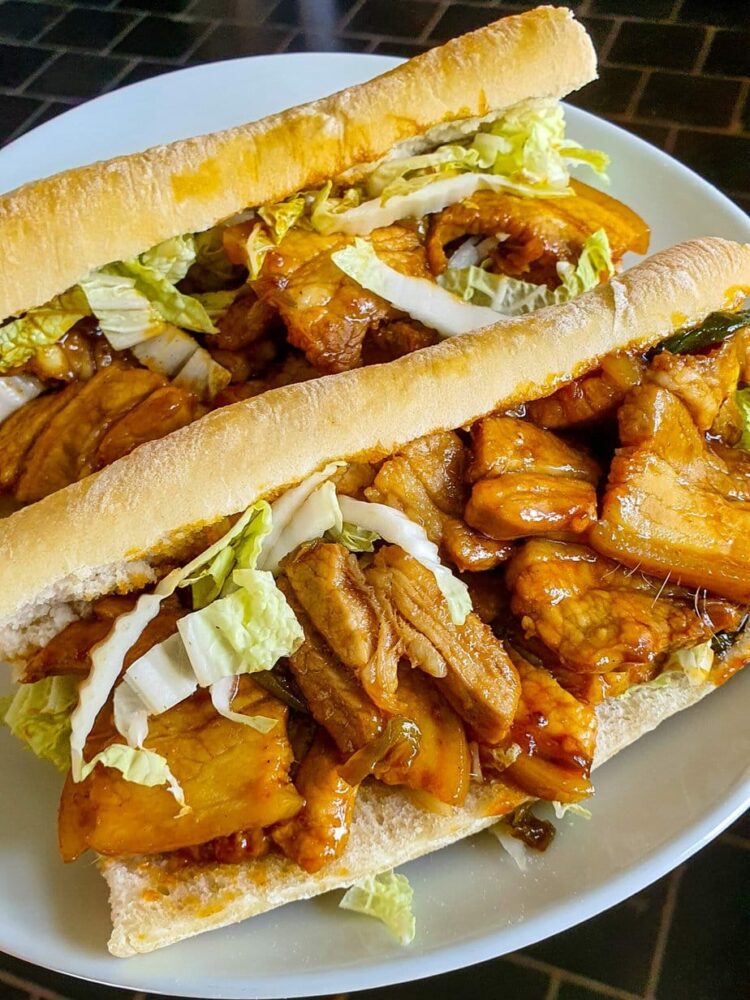A simple, delicious recipe for Vietnamese bánh mì
At dawn, the first thing you hear in Ho Chi Minh City is the dull crack of a still-warm baguette splitting open. A puff of steam escapes, carrying aromas of buttery pâté, rendered pork fat, and fresh cilantro—a signal to cooks, commuters, and bleary-eyed students that it’s time for breakfast.
In this handheld bundle, the bánh mì condenses 160 years of colonial collision and Vietnamese ingenuity: French technique, local thriftiness, a tropical need for freshness, and an almost philosophical demand for balance. Bite after bite, authenticity reveals itself through contrast: a whisper-thin crust against cottony crumb, velvety liver against crunchy pickled vegetables, generous pork against handfuls of herbs. Follow this trail of crumbs and you’ll discover its past, its architecture, the regional dialects it speaks—and the criteria to judge (or make) the real deal.
What is bánh mì?
It all starts with the bread. A Vietnamese baguette is a featherweight projectile, 15 cm to 20 cm long, baked with steam so the crust shatters like glass while the inside remains almost hollow. Historically, rice flour was added during shortages; today, many bakeries achieve lightness with a high-protein wheat flour and a touch of ascorbic acid, though some still incorporate a hint of rice flour. Whatever the formula, vendors always warm the bread for a few seconds before assembly: it’s the difference between a merely pleasant chew and that signature crackle.
Start with the base: a quick swipe of butter-mayo and a generous layer of liver pâté. In the North, the pâté is left coarse and distinctly porky; in the South, it’s whipped silky with extra fat. Hanoi has a saying: “Pâté accounts for 70% of the flavor,” and when you see it melting into the warm crumb, the math feels right.
At the heart is the meat, most often a pork triptych (silky chả lụa or Chả Huế, rosy ham, and pepper-flecked head cheese), though charcoal-grilled thịt nướng, Chinese-style xá xíu, meatballs in sauce, or lemongrass chicken can take the lead without anyone complaining. The key is that the protein stays seasoned in the Vietnamese way and shares the stage.
For freshness: chilled cucumber batons, a shower of sweet-and-sour carrot and daikon (đồ chua), sprigs of cilantro, and thin slices of Thai chili. In the South, it’s finished with a touch of light soy sauce; in the North, a pinch of salt and pepper with a local chili sauce is preferred. Nước mắm is generally used for the marinade rather than being poured directly onto the bread. The goal is to keep a clear balance between savory meat, refreshing vegetables, and delicate bread, so the palate stays awake rather than saturated (ăn hoài không ngán).
The story of bánh mì
The story begins in the 1860s, when the French colonists shipped their beloved baguette to Indochina. Wheat—imported, expensive, and prestigious—made bread a luxury; the Vietnamese dubbed it bánh tây (“Western bread”) and ate it simply with butter or sweetened condensed milk.
World War I shortages forced bakers to stretch dough with cheaper rice flour, and the accidental result was a revelation: a lighter, airier bread suited both to the tropical climate and local wallets.

The true turning point came a generation later, in Saigon, in 1958. In a narrow stall on Cao Thắng Street, Hòa Mã bakery shrank the baguette to about 20 cm, swapped melting French butter for a mayonnaise that withstands heat far better, and filled the bread instead of serving the meat on the side. Local cold cuts, quick-pickled vegetables, and garden herbs then transformed a colonial snack into a portable Vietnamese meal. Bicycle street vendors spread the formula throughout the city for just a few coins.
While the South celebrated abundance, the harsher postwar economy of Hanoi maintained a pared-down version: thick pâté, a thin layer of butter, sometimes a few strands of dried pork, a touch of chili and pepper—no pickles, few herbs. Both variants are faithful mirrors of their contexts: one luxuriates, the other pares back. After 1975, the Vietnamese diaspora carried bánh mì to Paris, California, Sydney, and beyond. In 2011, the Oxford English Dictionary enshrined the word, and today the sandwich is celebrated worldwide as one of the best on the planet.
The main bánh mì variations
To be clear, there are no rules when it comes to bánh mì. For instance, the version I share later is quite different from what’s described here. The goal is to show you the most popular combinations so you can build your own bánh mì without sticking to a rigid template.
Bánh mì ingredients
Possible bases for bánh mì:
- Pâté
- Mayonnaise
- Con Bò Cười (Laughing Cow cheese)
- Asian-style garlic and honey sauce
Possible pickled vegetables for bánh mì:
- Grated carrots
- Daikon (white radish) grated
Possible fresh vegetables and herbs for bánh mì:
- Napa cabbage grated
- Cucumber
- Cilantro
- Grated carrots
- Bok choy
- Scallions
Possible fillings for a banh mi:
- Ruốc thịt lợn (pork floss)
- Char siu (Cantonese barbecued pork)
- Pork liver pâté
- Giò lụa / chả lụa (Vietnamese mortadella)
- Tofu
- Seitan
- Stir-fried pork belly
Bánh mì by region
Northern Vietnam bánh mì tends to feature a base of pork liver pâté, pan-seared pork slices, pork floss, and cheese.
Southern Vietnam bánh mì leans more toward mayonnaise, butter, and egg yolks, sprinkled with fried onions and scallions.
The vegetarian version is often made with seitan.
For breakfast, some Vietnamese add an omelet, slices of onion, and good old soy sauce.
How to make bánh mì

It’s very simple. First, slice your fillings. Then marinate the meat (here, pork belly) and stir-fry it in a wok.
Split half a baguette; spread on the base, add the meat, then pile on the vegetables and any other chosen ingredients.
Ingredients for the bánh mì recipe
Light soy sauce: A classic light, salty soy sauce you can find in absolutely every supermarket nowadays. Really no excuse not to get some!
Oyster sauce: It doesn’t taste of oysters, but it’s essential to the flavor of many Asian dishes. You can substitute it imperfectly, but I recommend seeking it out.
Fish sauce: A dish isn’t Vietnamese without good fish sauce. Make the investment—you won’t regret it. It adds an indescribable depth (think umami) with beautifully layered savoriness.
Chili flakes or gochugaru: Korean chili flakes with a wonderfully deep flavor; you can substitute another chili powder, but this one is especially delicious.
The bánh mì recipe

Ingredients
- 200 g sliced pork belly (unsalted)
Marinade
- 1 tablespoon light soy sauce
- 1 teaspoon fish sauce
- 1 teaspoon oyster sauce
- 2 teaspoons fresh lemongrass, finely minced
Spicy mayo base
- 3 tablespoons mayonnaise
- 1 teaspoon white pepper
- 1 teaspoon chili flakes
- 1 teaspoon ground cumin
Toppings
- 30 g Vietnamese pickled vegetables
- 1 half a baguette
Instructions
- Marinate the pork for 10 minutes. In a bowl, stir together the spicy mayo base.
- Stir-fry the pork over high heat until cooked through.
Assembling the banh mi
- Slice the baguette lengthwise.
- Spread the spicy mayo.
- Add the toppings.
- Add the pork.
Notes
- Mix the base ahead of time to let the aromatics infuse the mayonnaise.
- I’ll be honest: I was in a hurry that day, and the photo is TERRIBLE. Next shoot, I’ll use a leaner cut of pork, marinate it longer, and slice it very thinly.
Nutrition
Culinary sources
- Nguyen, Andrea. The Bánh Mì Handbook – interview and excerpts.
Site: NPR — https://www.npr.org/ - Lion Brand Blog. History and Origins of Bánh Mì.
Site: https://lionbrand.com.au/ - XoTours Decoding Bánh Mì.
Site: https://xotours.vn/ - Paté Truyền Thống Hà Nội. Bánh Mì Traditions: Hanoi vs. Saigon.
Site: https://patetruyenthonghanoi.com/ - Wikipedia. Bánh Mì (history and ingredients).
Site: https://en.wikipedia.org/wiki/Bánh_mì

